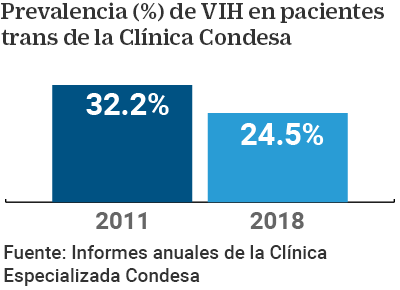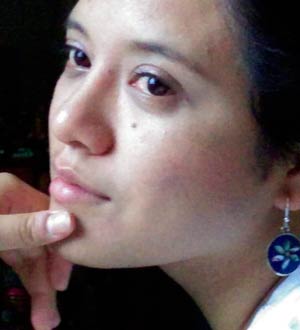


Written by: Carmina de la Luz / México
The whole town remembers Violeta well: how she walked through the streets headed to the dances, wearing red, purple, and sequin dresses. She had very dark skin, extremely white teeth, and a spectacular silhouette that she moved elegantly with some stylized platforms.
Violeta was murdered over 20 years ago but her mother cries her loss as if it had been yesterday: “He appeared next to the highway, all beaten,” she says, without being able to talk about her trans daughter with the identity she was given at birth.
According to the Observatory of Murder Against Transsexual People–that belongs to the international organization Transgender Europe–between October 1, 2016 and September 30, 2017, 325 murders of trans people were reported in the world. 267 of them took place in Latin America, many of them in Mexico. Our country is the second most dangerous for trans people, only under Brazil.
Nevertheless, hate and transphobia are not the only social phenomena that infringe upon that community. Bullying, discrimination, stigmatization, and the lack of laws that guarantee people’s integrity, mostly regarding health, are just as lethal, or even more.
The Mexican Human Rights Commission (NHRI) acknowledges that the transgender, transsexual, and transvestite population must be granted the same privileges in health matters as any other person, free from stigma and discrimination, and adapted to their needs. But, how can this right be exerted when so much is unknown about its recipients?

Institutions such as the Pan American Health Organization (PAHO) acknowledge the link between marginalization and sanitary issues. In Latin America, for instance, the most excluded populations are those that receive less health information and, as one of the consequences, they usually have a higher mortality rate compared to the rest of the population. This is the case of trans women and men who, historically, have been made invisible as a part of society.
According to information from the United Nations Development Program and UNAIDS, between 0.1% and 1.1% of the world’s population corresponds to trans people. Regarding Mexico, a document updated in May 2018 by the Council to Prevent and Eliminate Discrimination in Mexico City (COPRED), it is acknowledged that there is no available public demographic information about the total population of trans people.
Some isolated efforts, such as the international data cross-reference with information from the National Council of Population, suggest that, in Mexico, there could be between 81,000 and 183,600 adolescent trans between 13 and 18 years old. Meanwhile, the estimated amount by the National Center for the Prevention and Control of HIV/AIDS (CENSIDA) is of over 112,000 persons.
Certainly, Condesa Specialized Clinic has generated most knowledge about the Mexican trans population. In 2016, this institution – dependent on Mexico City’s Health Ministry – calculated that between 0.3% and 0.5% of the national population could be trans; that is, between 360,000 and 600,000 persons could be victims of violence and discrimination at home, school, work, and health services due to their gender identity.
Located in a borough by the same name, Condesa Clinic is considered a triumph of the demands of civil society. It is made up of a two-floor building used daily by doctors, patients, relatives, social workers, nurses, and diverse specialists. It was created in 2000 to offer treatment to persons infected by Human Immunodeficiency Virus (HIV), but little by little, due to the high incidence of HIV in certain groups of the population, its services have diversified.
In 2009, the Clinic opened a line of work for trans people. Luis Manuel Arellano – Coordinator of Community Integration of Mexico City’s HIV program – points out that the center complied to a reform of the City’s Health Act. Since then, the chapter 5 section 21 establishes that one of the assignments of Mexico City’s Health Ministry is “to carry out an attention program specialized in the health of transgender and transsexual people through, on its case, the supply of hormones, psychotherapeutic support, and the implementation of preventive measures and medical treatment corresponding to sexually transmitted infections and HIV-AIDS.”
Arellano says that 10 years ago, the country lacked any experience regarding the attention of trans people: “Condesa Clinic was the first demonstration of visibility for that population and, as a monitoring space, we have found an evolution to the access of health and in the incorporation of the transgender population to social spheres.” The also journalist and communicator recognizes it is a slow process, but compared to the previous decade, there is a huge difference.

In theory, Mexico has the Protocol for the Access to Medical Attention Without Discrimination for the Lesbian, Gay, Bisexual, Transsexual, Transvestite, Transgender, and Intersexual Population, whose last update was published on May 2019 by the Health Ministry. The problem is that, in practice, Condesa Specialized Clinic is the only public center in Mexico that gives service to trans people and it is the biggest institution of its kind in Latin America.
The lack of focalized services is reflected in the data of the Research on the Attention of LGBT People in Mexico 2015, for only between 20% and 14% of trans women and men who participated in the study, respectively, said they have had access to health services for their gender reaffirmation.
In this country, it is a reality that the trans population, especially trans women and their health requirements, became visible only after the HIV epidemic. That was the circumstance that turned Condesa Clinic into the ideal place to provide support to that community.
“During the first years of the program, a third part of the trans women who came to Condesa Clinic for their hormone treatment had HIV,” stresses Luis Manuel Arellano, “in that moment, the epidemiological monitoring of HIV infections at a national level was only classified by sex, man or woman, so Condesa Clinic was the first institution to expand the criterion based on gender identity; in the end, this made the rest of the institutions in health matters, including CENSIDA, to open a new category for the gender registry.”

Hugo André perceives himself as a trans man: “I think that I noticed since I was born; well, since I can recall,” he says smiling. He lived his childhood in a relatively easy way but it was during adolescence when changes related to his sex started to accentuate. “It was very frustrating and, although I resigned in some way, I still had the feeling that something was not right; people saw me and even [they] knew there was something different in me, for I didn’t fit in with the man/woman stereotypes; I suffered a lot and was bullied.”
André’s life completely changed when he started high school. He began his transition. He cut his hair as he had always wanted to and became a tomboy; however, he still was upset with his voice not corresponding to what he saw in the mirror. Two years later, in 2017, he found the term “trans” in a documentary: “I said ‘Oh, this is what I am, I’m definitely this’; I told my parents and asked for their support to start my hormone treatment.”
Today, André is 19 years old and he has been regularly attending Condesa Clinic for seven months to receive the therapy that helps him reaffirm his identity. This center has a very precise algorithm to work with trans people. Its starting points are the patient’s psychological and psychiatric assessment. With that, they diagnose if the patient is a trans person with or without real-life experience, which determines the kind of counseling they will receive.
“Then, patients start hormone treatment, adjusted to each individual’s characteristics and considering the comorbidities that could exist, as a possible HIV infection or other sexually transmitted diseases, hypertension, depression, or anxiety, excess weight, etc.,” as described by doctor Mitzi Fong, an endocrinologist who has focused her career in helping trans people. Fong and her colleagues monitor their patients every three months during the first year of treatment and, after that, they have consultations every six months.
André dreams of being a high-level physical trainer. For now, he studies a degree in Sociology at the National Autonomous University of Mexico (UNAM), but he has already been accepted in the Sports Sciences major. Among his plans are a double mastectomy – breast tissue removal – and a hysterectomy – a surgery to remove the uterus, fallopian tubes, and ovaries – for both procedures would help him feel completely fulfilled with his identity.
In order to do that, Hugo André will have to go to a private surgeon since, until now, no health regulation in Mexico covers gender reassignment surgeries. In that sense, doctor Esmeralda Román – coordinator of endocrinology services for trans persons at Condesa Clinic, as well as at Iztapalapa – stresses out that they are expensive procedures: “For a well-done mastectomy, in the case of trans men, we are talking about between MXN $30,000 and $70,000; in the case of trans women, surgical procedures exceed MXN $250,000.”
Abigail Madariaga, Natalia Cruz, Rocío Suárez, Kassandra Guazo, and Melken Mejía are part of the Trans Identities Care Center. These five women agree that the health requirements of their population are very different from those of trans men and cis persons in general. They also agree that the labor done by Condesa Clinic has been extraordinary but, at the same time, they are aware that their services are insufficient.
“Health matters for trans women have focused on certain aspects: hormone therapy, prevention and care of HIV and other STDs, and problems due to the infiltration of substances to sculpt the body,” points out Natalia, “however, a real comprehensive care would have to deal with other health problems, from a common cold to gender reassignment surgeries.”
The latter are seen by society as vanity, when in reality they play an essential role in the mental health of trans people and they could even prevent low-self-esteem problems, substance abuse, or suicide: “We, trans women, subject ourselves to this kind of procedures that support our comprehensive development to be able to reaffirm our identity as women,” says Natalia.
These five activists’ remarks are particularly relevant in front of the proposal of Mexico City’s new administration to create a comprehensive clinic for the care of trans people with a community focus. In that regard, Kassandra wonders “What does a comprehensive health service mean for authorities? They promised the same when the trans people area opened at Condesa Clinic, for the Act and the Protocol only cover hormones. Specialties are very limited, and if you’re not a trans person living with HIV, then you don’t have a right to dental care or urology care, for example.”
She and her colleagues are in favor of the creation of a space of this kind, however, they also vow for alternative solutions. “The government should guarantee care in three levels of service: each community’s health center, regional clinics, and high-specialty hospitals,” suggests Melken.
“I remember that, for a long time, we, trans activists, thought that when we could change our legal identity according to our gender, it would be the key to our rights, including health ones. But no, although it is very important, it is only one of the doors,” , mentions Rocío Sánchez, coordinator of the Trans Identities Care Center.
Although the Political Constitution of the United Mexican States in the fifth paragraph of its first article forbids “to exert any action that infringes upon human dignity, or that cancels or undermines rights and liberties of persons for prejudices of gender, sex, sexual preferences, among others,” the NHRI accepts that the corresponding legal framework has not permeated in the social reality of trans people.
Since 2008, Mexico’s Supreme Court (SCJN) recognized through the Direct Civil Writ of Amparo 6/2008 that, in those cases in which people who live with a gender that does not correspond to the one society assigned them, the ratification of identity documents, such as the birth certificate, must be allowed. However, this measure lacked a specific regulation, so Mexico City became practically the only place where trans people dared to perform this procedure; nevertheless, it was a judicial procedure where it was necessary to have lawyers and experts, causing discrimination and stigma.
Some years later, the capital made some progress. Since April 2015, thanks to a modification in Mexico City’s civil code, it was possible to change legal identity so that it matched the person’s gender identity. It is a relatively simple procedure in the civil registry, in which it is not necessary to prove any surgery, therapy, diagnostic and/or procedure.
The legal adjustment had very evident results. According to data provided by Mexico City’s Legislative Assembly, between October 2008 and February 2014, only 164 persons had changed their documents. On the other side, between February 2015 and July 2017, the number of name and gender rectifications in official documents rose to 1,923 people.
Mexico City has been an example for other entities in the country, for the corresponding reforms have already been applied to the civil codes of the states of Michoacán, Nayarit, Coahuila, and Colima. Meanwhile, in Hidalgo, Chiapas, Morelos, and Sonora, civil society is pushing to obtain the same right.
Regarding this gap, Rocío thinks that “Mexico City will not change the country. I think that new generations of trans people will be able to access more education and jobs, but I also think that we cannot forget the lost generations; we must transit those lost generations so that the rest of the country can reach, at least, the achievements of the capital.”
The construction of Paulo Romo’s gender identity started at an early age. Proud, he shows all his official documents: birth certificate, Unique Population Registry Code (CURP), and voter card. Pablo was always curious about the origin of things, which led him to study biology and, later on, to do a doctorate in paleontology. “I thought science would explain to me why I was how I was; that maybe it was a chromosomal variation or due to a metabolic alteration,” he confesses, “but now I know that there are many things science cannot tell about trans identities.”
What science can do is generating knowledge that helps fighting one of the cores of injustice for trans people, pathologization. That is, the idea that being trans is a synonym of disease.
On July 27, 2016, Mexico became the first country to carry out a field study that showed scientific evidence about trans identity as a condition and not a mental illness. The research was published by The Lancet Psychiatry–one of the most important journals in the world in the area of psychology and psychiatry–and it was headed by the “Ramón de la Fuente Muñiz” National Institute of Psychiatry, during a time in which the transgender concept was still seen as an illness, according to the International Classification of Mental Illnesses of the World Health Organization. Condesa Clinic and UNAM also participated in the study.
The protocol included a survey with adult trans people who said they identified as such at the age of 5.6 years, on average, ranging from 2 to 17 years old. The conclusions were that the traits of stress, dysfunction, and mental disorders so frequent in this population do not come from their condition itself, but from stigmatization and social mistreatment.
The study was replicated in different countries, such as France, Brazil, India, Libya, and South Africa. It had a huge impact, for based on the results, on June 18, 2018, the WHO decided to remove “gender incongruence” from its list of diseases. Over time, this change will be the key to guarantee trans people’s human rights and their health protection through adequate legal instruments.
Activism, regulations, and scientific studies arrived too late for Violeta. She was, in the end, a victim of pathologization, which represents the border of the abyss of discrimination, stigma, and hate. Being a girl, her father hit her every time she tried to express herself; mockery at school made her abandon her education, and the hostile environment at her home forced her to escape.
Violeta found shelter with Doña Margarita, owner of a canteen where the young woman became a sex worker at only 17 years of age. “Even then he was happy, and he helped me whenever he could,” tells her mother, “until one day he went to the city and never came back.”
When they found her, Violeta’s body showed she had fought until her last breath, but once her life was taken, someone else took her identity. It was the Medical Forensic Service (SEMEFO) that, over 20 years ago, registered Violeta’s death as a man’s.

Carmina de la Luz Born in the Mexican state of Guerrero, disseminator, and journalist with studies in Biology. She defines herself as a Communication-sciences zombie. She has been a TV host and her written work has been published in Todo sobre el espacio, Mexico Desconocido, and the Tangible portal of EL UNIVERSAL newspaper. Fellow in programs of the Thomson Reuters Foundation and the Council for Advancement of Science Writing. Member of the Mexican Society for the Disclosure of Science and Technology (SOMEDICYT) and the Mexican Network of Science Journalists (RedMPC).
Four journalists collaborating with Tangible walked the path of trans people in Mexico, Costa Rica, Venezuela, and Argentina. These are the stories unfolded from otherness.